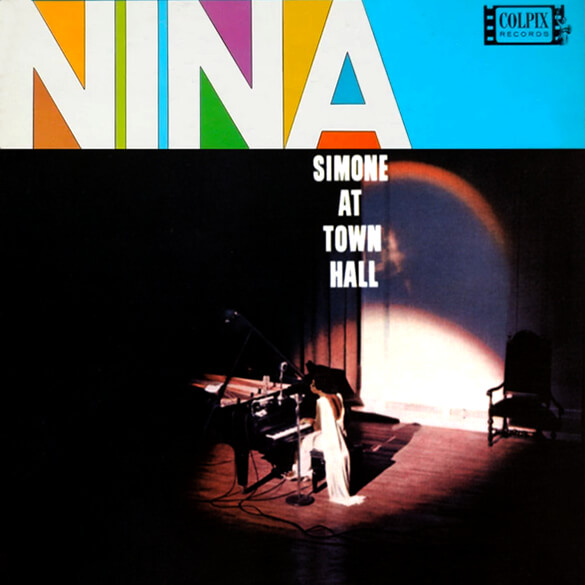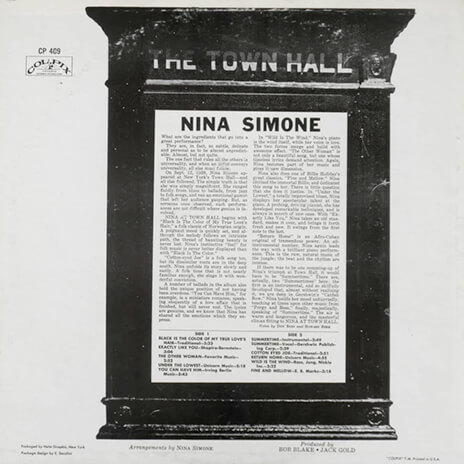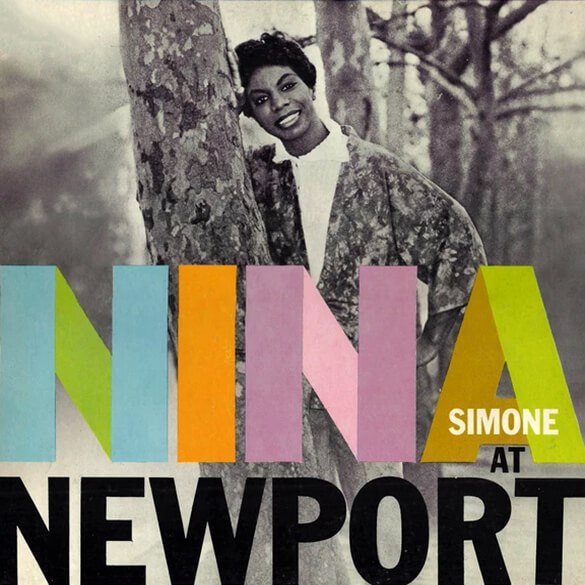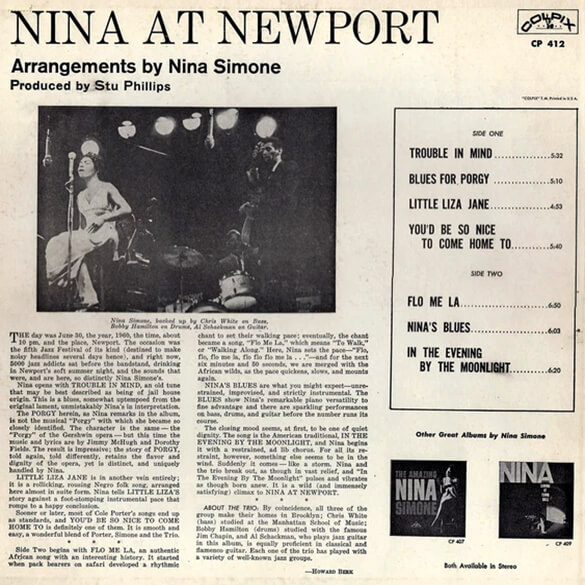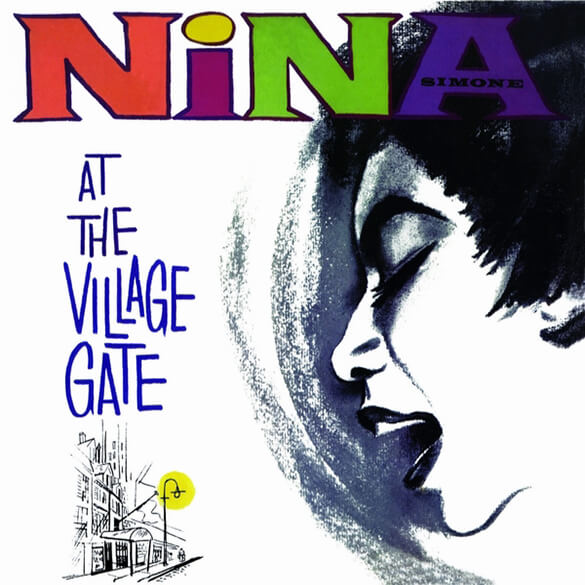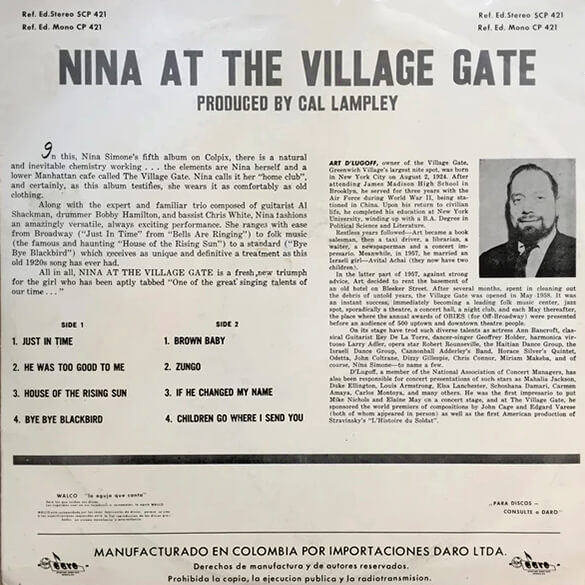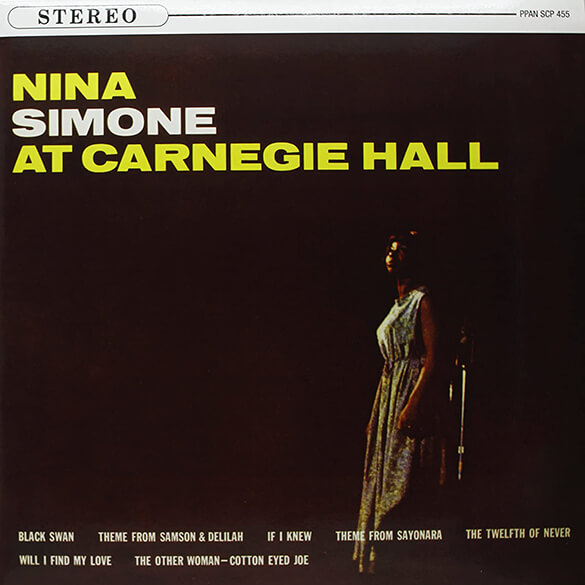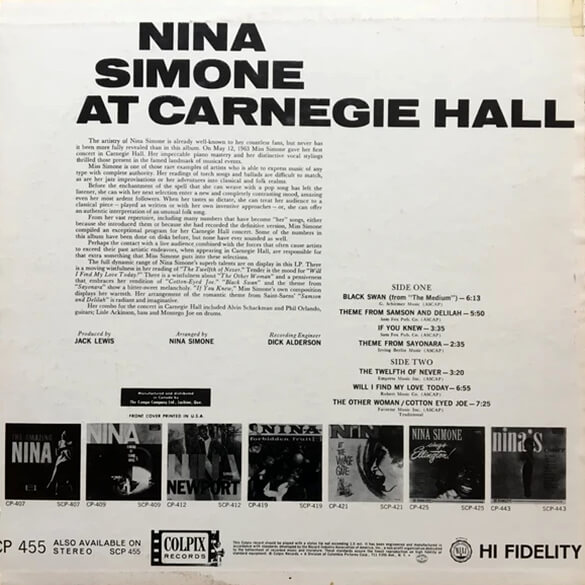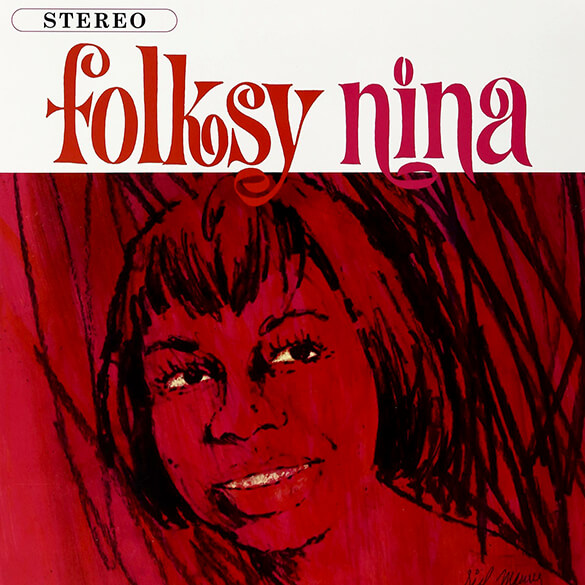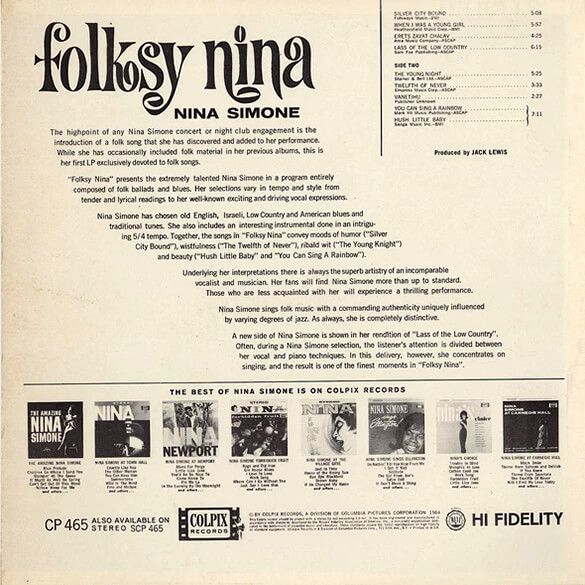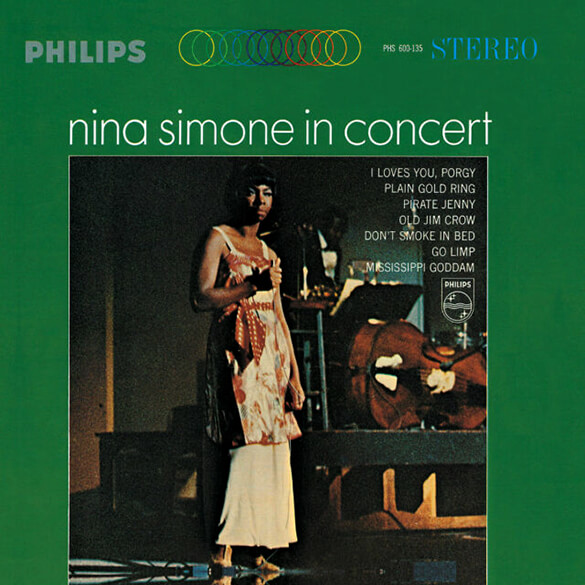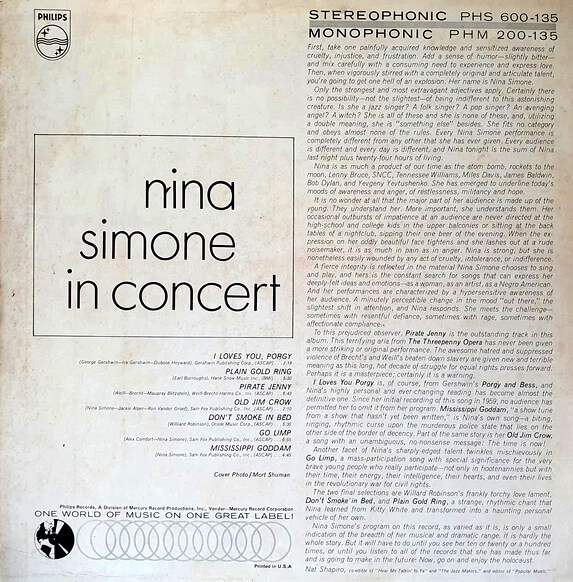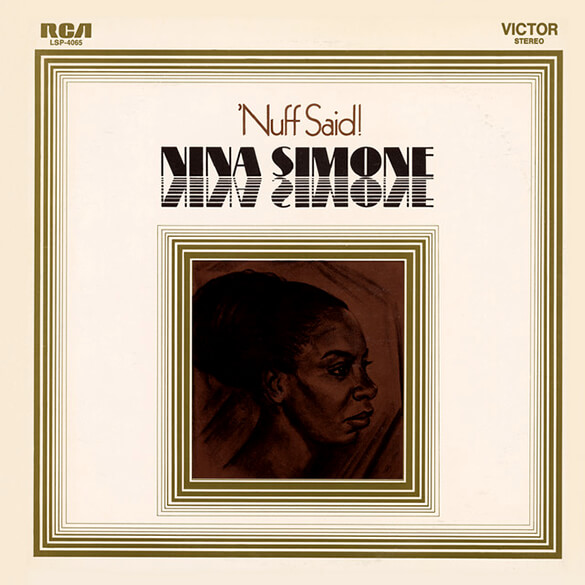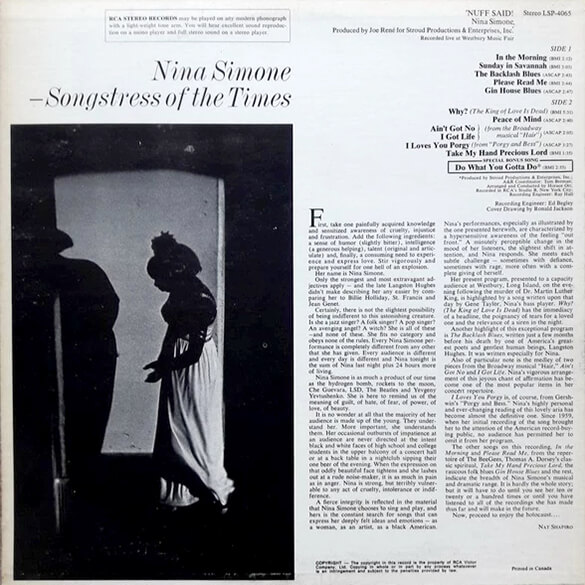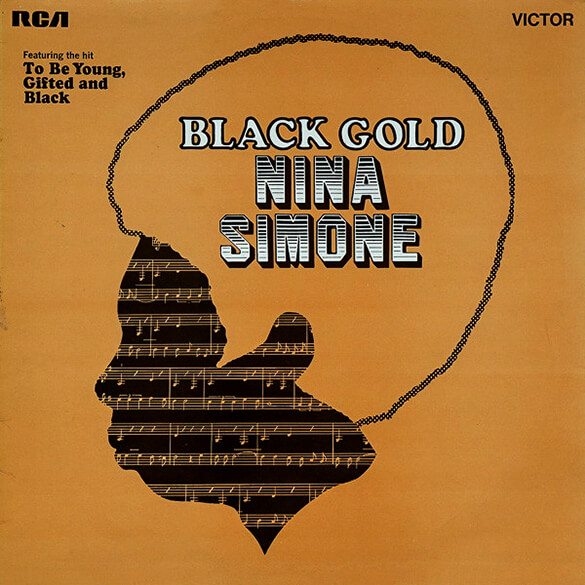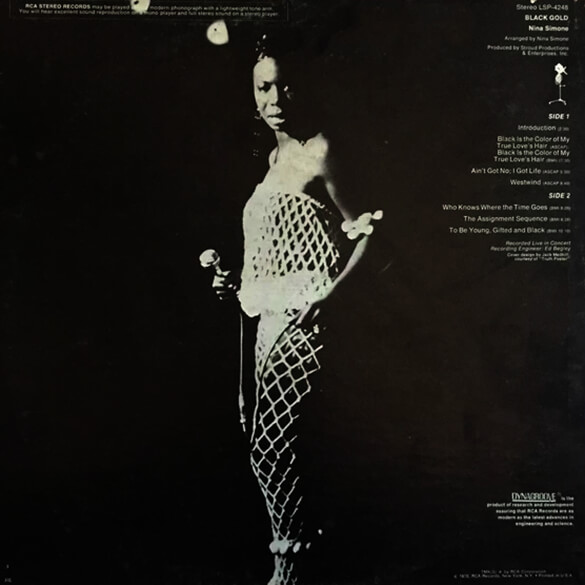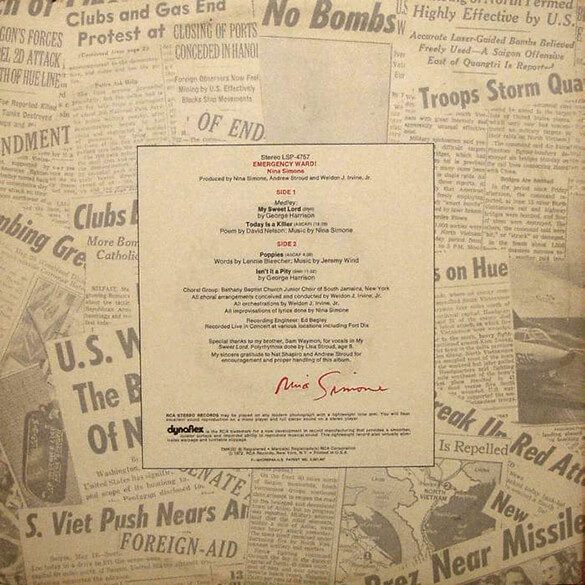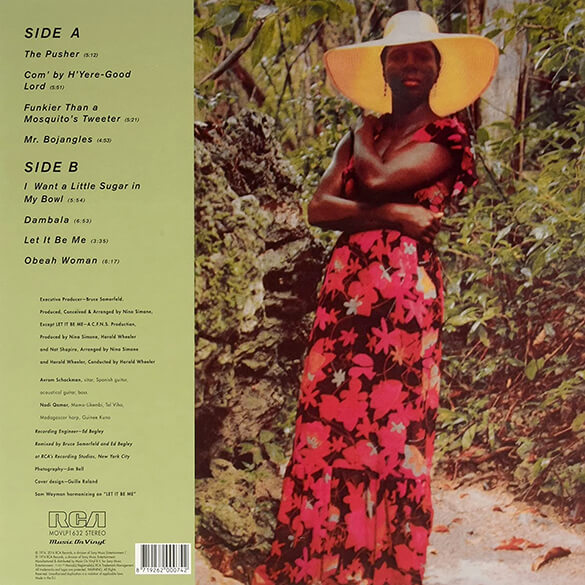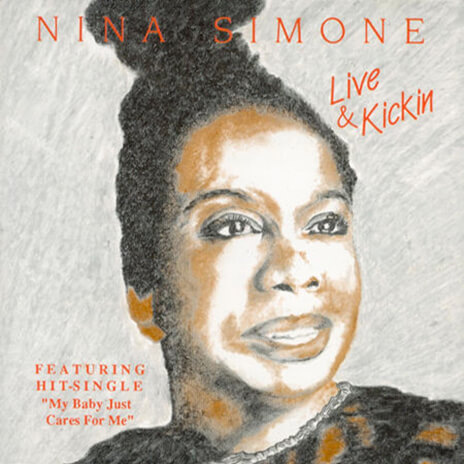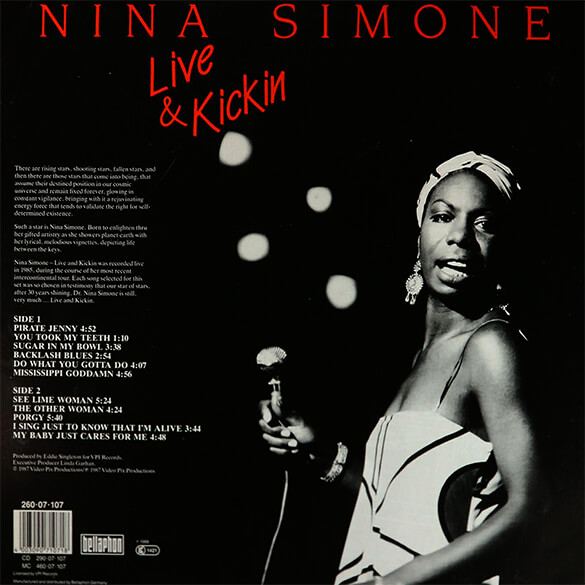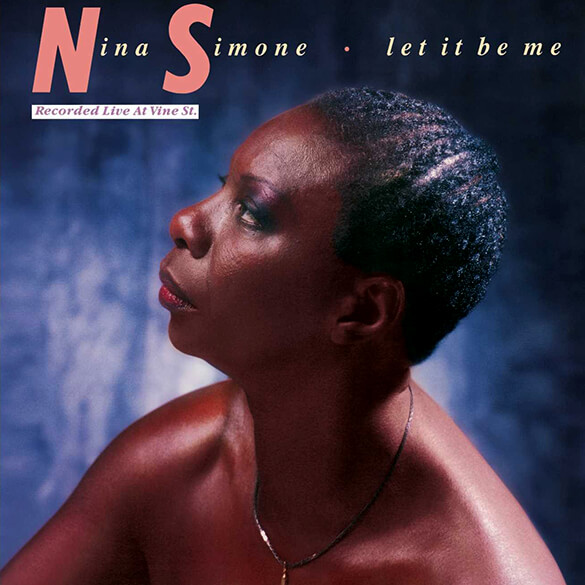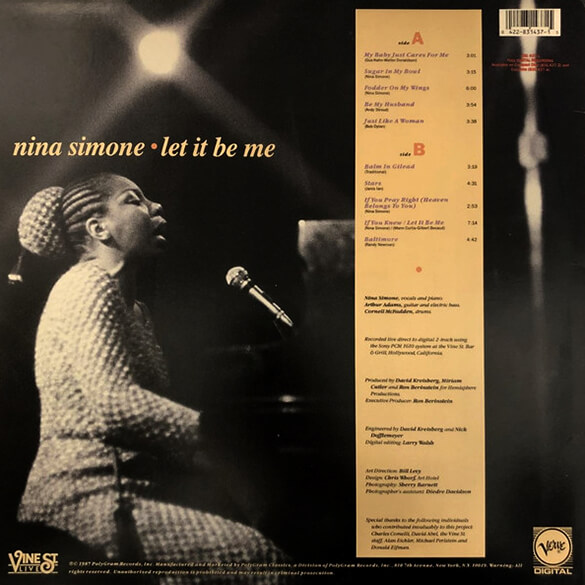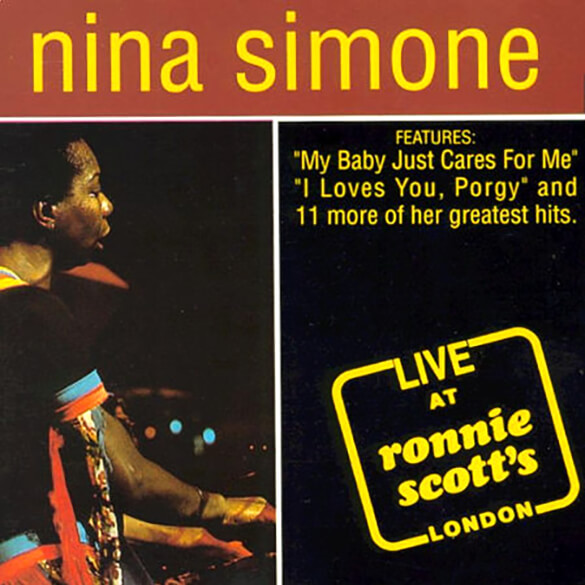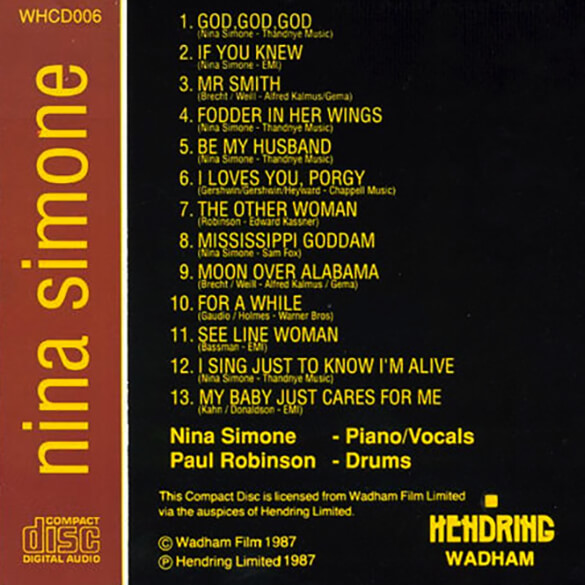- Black Is The Color Of My True Love’s Hair
- Exactly Like You
- The Other Woman
- Under The Lowest
- You Can Have Him
- Summertime
- Cotton Eyed Joe
- Return Home
- Wild Is The Wind
- Fine and Mellow
- Nina Simone – vocals, piano, arrangements
- Bob Blake – producer
- Jack Gold – producer
- Ernest Socolov – cover design
- Herb Snitzer – photography
- Don Ross – liner notes
- Howard Berk – liner notes
Recording session: Town Hall – New York City – September 12, 1959
Catalog number: CP 409 / SCP 409
Liner notes:
What are the ingredients that go into a great performance? They are, in fact, so subtle delicate and personal as to be almost unpredictable. Almost, but not quite. The one fact that rules all the others is universality, and when an artist conveys universality, all else must follow.
On Sept. 12, 1959, Nina Simone appeared at New York’s Town Hall – and all else followed. The simple truth is that she was simply magnificent. She ranged fluidly from blues to ballads, from jazz to folk songs, and ran an emotional gamut that left her audience gasping. But, as someone once observed, such performances are not difficult where genius is involved.
“Nina At Town Hall” begins with “Black Is The Color Of My True Love’s Hair,” a folk classic of Norwegian origin. A poignant mood is quickly set, and although the melody follows an intricate path, the thread of haunting beauty is never lost. Nina’s instinctive “feel” for folk music is never better displayed than with “Black Is The Color.”
“Cotton-Eyed Joe” is a folk song, too, but its dissimilar roots are in the deep south. Nina unfolds its story slowly and easily. A folk tune that is not nearly familiar enough, she sings it with wonderful conviction.
A number of ballads in the album also hold the unique position of not having been overdone. “You Can Have Him,” for example, is a miniature romance, speaking eloquently of a love affair that is finished, but will never end. The lyrics are genuine, and we know that Nina has shared all the emotions which they express.
In “Wild Is The Wind,” Nina’s piano is the wind itself, while her voice is love. The two forces merge and build with awesome effect. “The Other Woman” is not only a beautiful song, but one whose timeless lyrics demand attention. Again, Nina becomes part of her music and gives it new dimension.
Nina also does one of Billie Holiday’s great classics, “Fine and Mellow.” Nina idolized the immortal Billie, and dedicated this song to her. There is little question that she does it justice. In “Under The Lowest,” a totally improvised blues, Nina displays her spectacular talent at the piano. A probing, driving pianist, she has developed remarkable techniques and is always in search of new ones. With “Exactly Like You,” Nina takes an old standard, makes it over, and brings it forth fresh and new. It swings from the first note to the last.
“Return Home” is an Afro-Cuban original of tremendous power. An all-instrumental number, Nina again leads the way with a brilliant piano performance. This is the raw, natural music of the jungle; the beat and the rhythm are intense.
If there was to be one summing-up of Nina’s triumph at Town Hall, it would have to be “Summertime.” There are, actually, two “Summertimes” here; the first is an instrumental, and so skillfully developed that, almost with realizing it, we are deep in Gershwin’s “Catfish Row.” Nina builds her mood unhurriedly, touching at times upon other music from “Porgy and Bess,” finally, majestically, speaking of “Summertime.” The air is warm and languorous, and the masterful climax fitting to NINA AT TOWN HALL.
ALTERNATE COVERS:

ABRIDGED VERSIONS:

EXPANDED EDITIONS:
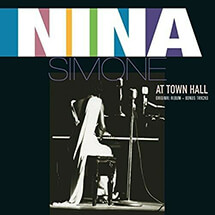
AT TOWN HALL (2016)
Additions: Vaynikehu; Sinnerman
- Trouble In Mind
- Porgy
- Little Liza Jane
- You’d Be So Nice To Come Home To
- Flo Me La
- Nina’s Blues (Instrumental)
- In The Evening By The Moonlight
- Nina Simone – vocals, piano
- Al Schackman – guitar
- Chris White – bass
- Bobby Hamilton – drums
- Stu Phillips – producer
- Howard Berk – liner notes
Recording session: Newport – Rhode Island – June 30, 1960
Catalog number: CP 412 / SCP 412
Liner notes:
The day was June 30, the year, 1960, the time, about 10pm, and the place, Newport. The occasion was the fifth Jazz Festival of its kind (destined to make noisy headlines several days hence), and right now, 5000 jazz addicts sat before the bandstand, drinking in Newport’s soft summer night, and the sounds that were, and are here, so distinctly Nina Simone’s
Nina opens with TROUBLE IN MIND, an old tune that may be best described as being of jail house origin. This is a blues, somewhat uptempoed from the original lament, unmistakably Nina’s in interpretation.
The PORGY here, as Nina remarks in the album, is not the musical “Porgy” with which she became so closely identified. The character is the same – the “Porgy” of the Gershwin opera – but this time the music and lyrics are by Jimmy McHugh and Dorothy Fields. The result is impressive; the story of PORGY, told again, told differently, retains the flavor and dignity of the opera, yet is distinct and uniquely handled by Nina.
LITTLE LIZA JANE is in another vein entirely; it is a rollicking, rousing Negro folk song, arranged here almost in suite form. Nina tells LITTLE LIZA’s story against a foot-stomping instrumental pace that romps to a happy conclusion.
Sooner or later, most of Cole Porter’s songs end up as standards, and YOU’D BE SO NICE TO COME HOME TO is definitely one of them. It is smooth and easy, a wonderful blend of Porter, Simone, and the Trio.
Side Two begins with FLO ME LA, an authentic African song with an interesting history. It started when pack bearers on safari developed a rhythmic chant to set their walking pace; eventually, the chant became a song, “Flo Me La,” which means “To Walk,” or “Walking Along.” Here, Nina sets the pace-“Flo, flo, flo me la, flo flo flo me la—“-and for the next six minutes and 50 seconds, we are merged with the African wilds, as the pace quickens, slows, and mounts again.
NINA’S BLUES are what you might expect – unrestrained, improvised, and strictly instrumental. The BLUES show Nina’s remarkable piano versatility to fine advantage and there are sparkling performances on bass, drums, and guitar before the number runs its course.
The closing mood seems, at first, to be one of quiet dignity. The song is the American traditional, IN THE EVENING BY THE MOONLIGHT, and Nina begins it with a restrained, ab lib chorus. For all its restraint, however, something else seems to be in the wind. Suddenly it comes out – like a storm, Nina and the trio break out, as though in vast relief, and “In The Evening By The Moonlight” pulses and vibrates as though born anew. It is a wild (and immensely satisfying) climax to NINA T NEWPORT.
ABOUT THE TRIO: By coincidence, all three of the group make their homes in Brooklyn. Chris White (bass) studied at the Manhattan School of Music; Bobby Hamilton (drums) studied with the famous Jim Chapin, and Al Schackman, who plays jazz guitar in this album, is equally proficient in classical and flamenco guitar. Each of the trio has played with a variety of well-known jazz groups.
ALTERNATE COVERS:

- Just In Time
- He Was Too Good To Me
- House of the Rising Sun
- Bye Bye Blackbird (Instrumental)
- Brown Baby
- Zungo
- If He Changed My Name
- Children Go Where I Send You
- Nina Simone – vocals, piano
- Al Schackman – guitar
- Chris White – bass
- Bobby Hamilton – drums
- Cal Lampey – producer
Recording session: The Village Gate – New York City – 1961
Catalog number: CP 421 / SCP 421
Liner notes:
In this, Nina’s fifth album on Colpix, there is a natural and inevitable chemistry working…the elements are Nina herself at a lower Manhattan café called The Village Gate. Nina calls it her “home club” and, certainly, as this album testifies, she wears it as comfortably as old clothing.
Along with the expert and familiar trio composed of guitarist Al Shackman, drummer Bobby Hamilton, and bassist Christ White, Nina fashions an amazingly versatile, always exciting performance. She ranges with ease from Broadway (“Just In Time” from Bells Are Ringing) to folk music (the famous and haunting “House of the Rising Sun”) to a standard “Bye Bye Blackbird”) which receives as unique and definitive a treatment as this old 1920s song has ever had.
All in all, NINA AT THE VILLAGE GATE is a fresh new triumph for the girl who has been aptly tabbed “One of the great singing talents of our time…”
ALTERNATE COVERS:

EXPANDED EDITIONS:
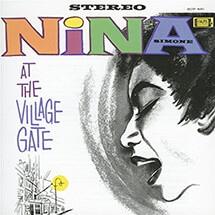
AT THE VILLAGE GATE (2005)
Additions: Eretz Zavat Chalav U'dvash; Vaynikehu; Sinnerman; You'll Never Walk Alone
- Black Swan
- Theme From Samson and Delilah
- If You Knew
- Theme From Sayonara (Instrumental)
- Twelfth of Never
- Will I Find My Love Today
- Medley
- The Other Woman
- Cotton-Eyed Joe
- Nina Simone – vocals, piano, arrangements
- Alvin Schackman – guitar
- Phil Orlando – guitar
- Lisle Atkinson – bass
- Montego Joe – drums
- The Malcolm Dodds Singers – backing vocals
- Dick Alderson – engineer
- Jack Lewis – producer
Recording session: Carnegie Hall – New York City – April 12, 1963
Catalog number: CP 455 / SCP 455
Liner notes:
The artistry of Nina Simone is already well-known to her countless fans, but never has it been more fully revealed than in this album. On May 12, 1963 Miss Simone gave her first concert in Carnegie Hall. Her impeccable piano mastery and her distinctive vocal stylings thrilled those present in the famed landmark of musical events.
Miss Simone is one of those rare examples of artists who is able to express music of any type with complete authority. Her readings of torch songs and ballads are difficult to match, as are her jazz improvisations or her adventures into classical and folk realms.
Before the enchantment of the spell that she can weave with a pop song has left the listener, she can with her next selection enter a new and completely contrasting mood, amazing even her most ardent followers. When her tastes so dictate, she can treat her audience to a classical piece – played as written or with her own inventive approaches – or, she can offer an authentic interpretation of an unusual folk song.
From her vast repertoire, including many numbers that have become “her” songs, either because she has introduced them or because she had recorded the definitive version, Miss Simone compiled an exceptional program for her Carnegie Hall concert. Some of the numbers in this album have been done on disks before, but none have ever sounded as well.
Perhaps the contact with a live audience combined with the forces that often cause artists to exceed their past artistic endeavors, when appearing in Carnegie Hall, are responsible for that extra something that Miss Simone puts into these selections.
The full dynamic range of Nina Simone’s superb talents are on display in this LP. There is a moving wistfulness in her reading of “The Twelfth of Never.” Tender is the mood for “Will I Find My Love Today?” There is a wistfulness about “The Other Woman” and a pensiveness that embraces her rendition of “Cotton-Eyed Joe.” “Black Swan” and the theme from “Sayonara” show a bitter-sweet melancholy. “If You Knew,” Miss Simone’s own composition, displays her warmth. Her arrangement of the romantic theme “Samson and Delilah” is radiant and imaginative.
Her combo for the concert in Carnegie Hall included Alvin Schackman and Phil Orlando, guitars; Lisle Atkinson, bass and Montego Joe on drums.
ALTERNATE COVERS:

EXPANDED EDITIONS:
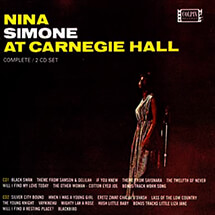
AT CARNEGIE HALL (2005)
Additions: Tracks from ‘Folksy Nina’ + Little Liza Jane; Will I Find A Resting Place; Blackbird
- Silver City Bound
- When I Was A Young Girl
- Erets Zavat Chalav
- Lass of the Low Country
- The Young Knight
- The Twelfth of Never
- Vanetihu
- Medley
- You Can Sing A Rainbow
- Hush Little Baby
- Nina Simone – vocals, piano, arrangements
- Alvin Schackman – guitar
- Phil Orlando – guitar
- Lisle Atkinson – bass
- Montego Joe – drums
- The Malcolm Dodds Singers – backing vocals
- Dick Alderson – engineer
- Jack Lewis – producer
Recording session: Carnegie Hall – New York City – April 12, 1963
Catalog number: CP 465 / SCP 465
Liner notes:
The highpoint of any Nina Simone concert or night club engagement is the introduction of a folk song that she has discovered and added to her performance. While she has occasionally included folk material in her previous albums, this is her first LP exclusively devoted to folk songs.
“Folksy Nina” presents the extremely talented Nina Simone in a program entirely composed of folk ballads and blues. Her selections vary in tempo and style from tender and lyrical readings to her well-known exciting and driving vocal expressions
Nina Simone has chosen old English, Israeli, Low Country, and American blues and traditional tunes. She also includes an interesting instrumental done in an intriguing 5/4 tempo. Together, the songs in “Folksy Nina” convey moods of humor (“Silver City Bound”), wistfulness (“The Twelfth of Never”), ribald wit (“The Young Knight”) and beauty (“Hush Little Baby” and “You Can Sing A Rainbow”).
Underlying her interpretations there is always the superb artistry of an incomparable vocalist and musician. Her fans will find Nina Simone more than up to standard. Those who are less acquainted with her will experience a thrilling performance.
Nina Simone sings folk music with a commanding authenticity uniquely influenced by varying degrees of jazz. As always, she is completely distinctive.
A new side of Nina Simone is shown in her rendition of “Lass of the Low Country.” Often, during a Nina Simone selection, the listener’s attention is divided between her vocal and piano techniques. In this delivery, however, she concentrates on singing, and the result is one of the finest moments in “Folksy Nina.”
ALTERNATE COVERS:

- I Loves You Porgy
- Plain Gold Ring
- Pirate Jenny
- Old Jim Crow
- Don’t Smoke In Bed
- Go Limp
- Mississippi Goddam
- Nina Simone – vocals, piano, arrangements
- Rudy Stevenson – guitar
- Lisle Atkinson – bass
- Bobby Hamilton – drums
- Hal Mooney – producer
- Nat Shapiro – liner notes
- Mort Shuman – photography
Recording session: Carnegie Hall – New York City – March 21, April 1, and April 6, 1964
Catalog number: PHS 600-135 / PHM 200-135
Liner notes:
First, take one painfully acquired knowledge and sensitized awareness of cruelty, injustice, and frustration. Add a sense of humor — slightly bitter — and mix carefully with a consuming need to experience and express love. Then, when vigorously stirred with a completely original and articulate talent, you’re going to get one hell of an explosion. Her name is Nina Simone.
Only the strongest and most extravagant adjectives apply. Certainly there is no possibility—not the slightest—of being indifferent to this astonishing creature. Is she a jazz singer? A folk singer? A pop singer? An avenging angel? A witch? She is all of these and she is none of these, and utilizing a double meaning, she is “something else” besides. She fits no category and obeys almost none of the rules. Every Nina Simone performance is completely different from any other night she has ever given. Every audience is different and every day is different, and Nina tonight is the sum of Nina last night plus twenty-four hours of living.
Nina is as much a product of our time as the atom bomb, rockets to the moon, Lenny Bruce, SNCC, Tennessee Williams, Miles Davis, James Baldwin, Bob Dylan, and Yevgeny Yevtushenko. She has emerged to underline today’s moods of awareness and anger, of restlessness, militancy, and hope.
It is no wonder at all that the major part of her audience is made up of the young. They understand her. Most important, she understands them. Her occasional outbursts of impatience at an audience are never directed at the high-school and college kids in the upper balconies or sitting at the back tables of a nightclub, sipping their one beer of the evening. When the expression of her oddly beautiful face tightens and she lashes out at a rude noisemaker, it is as much in pain as in anger. Nina is strong, but she is nonetheless easily wounded by any act of cruelty, intolerance, or indifference.
A fierce integrity is reflected in the material Nina Simone chooses to sing and play, and hers is the constant search for songs that can express her deeply felt ideas and emotions—as a woman, as an artist, as a Negro American. And her performances are characterized by a hypersensitive awareness of her audience. A minutely perceptible change in the mood “out there,” the slightest shift in attention, and Nina responds. She meets the challenge—sometimes with resentful defiance, sometimes with rage, sometimes with affectionate compliance.
To this prejudiced observer, Pirate Jenny is the outstanding track in this album. This terrifying aria from The Threepenny Opera has never been given a more striking or original performance. The awesome hatred and suppressed violence of Brecht’s and Weill’s beaten-down slavery are given new and terrible meaning as this long, hot decade of struggle for equal rights presses forward. Perhaps it is a masterpiece; certainly it is a warning.
I Loves You Porgy is, of course, form Gershwin’s Porgy and Bess, and Nina’s highly personal and ever-changing reading has become almost the definitive one. Since her initial recording of this song in 1959, no audience has permitted her to omit it from her program. Mississippi Goddam, “a show tune from a show that hasn’t yet be written,” is Nina’s own sing—a biting, ringing, rhythmic curse upon the murderous police state that lies on the other side of the border of decency. Part of the same story is her Old Jim Crow, a song with unambiguous, no-nonsense message: the time is now!
Another facet of Nina’s sharply-edged talent twinkles mischievously in Go Limp, a mass-participation song with special significance for the very brave young people who really participate—not only in hootenannies but with their time, their energy, their intelligence, their hearts, and even their lives in the revolutionary war for civil rights.
The two final selections are Willard Robinson’s frankly torchy love lament, Don’t Smoke In Bed, and Plain Gold Tin, a strange, rhythmic chant that Nina learned from Kitty White and transformed into a haunting personal vehicle of her own.
Nina Simone’s program on this record, as varied as it is, is only a small indication of the breadth of her musical and dramatic range. It is hardly the whole story. But it will have to do until you see her ten or twenty or a hundred times, or until you listen to all the records that she has made thus far and is going to make in the future. No, go on and enjoy the holocaust.
ALTERNATE COVERS:

- In The Morning
- Sunday In Savannah
- Backlash Blues
- Please Read Me
- Gin House Blues
- Why? (The King of Love Is Dead)
- Peace of Mind
- Ain’t Got No, I Got Life
- I Loves You Porgy
- Take My Hand Precious Lord
- Do What You Gotta Do
- Nina Simone – vocals, piano
- Rudy Stevenson – guitar
- Sam Waymon – organ
- Gene Taylor – bass
- Buck Clarke – drums
- Horace Ott – arranger, conductor (track 11)
- Joe René – producer
- Sammy Lowe – arrangements, conductor
- Ray Hall – engineer (track 11)
- Ed Begley – engineer
- Tom Berman – coordinator
- Ronald Jackson – cover design
- Nat Shapiro – liner notes
Recording session: Westbury Music Fair – Westbury, Long Island, New York – April 7, 1968 (except for tracks 1, 8, and 11, recorded at RCA Studios – New York City – May 13, 1968)
Catalog number: LSP-4065
Liner notes:
First, take one painfully acquired knowledge and sensitized awareness of cruelty, injustice, and frustration. Add the following ingredients: a sense of humor (slightly bitter), intelligence (a generous helping), talent (original and articulate) and, finally, a consuming need to experience and express love. Stir vigorously and prepare yourself for one hell of an explosion.
Her name is Nina Simone.
Only the strongest and most extravagant adjectives apply — and the late Langston Hughes didn’t make describing her any easier by comparing her to Billie Holiday, St. Francis, and Jean Genet.
Certainly, there is not the slightest possibility of being indifferent to this astonishing creature. Is she a jazz singer? A folk singer? A pop singer? An avenging angel? A witch? She is all of these—and none of these. She fits no category and obeys none of the rules. Every Nina Simone performance is completely different from any other that she has given. Every audience is different and every day is different and Nina tonight is Nina the sum of Nina last night plus 24 hours more of living.
Nina Simone is as much a product of our time as the hydrogen bomb, rockets to the moon, Che Guevara, LSD, The Beatles, and Yevgeny Yevtushenko. She is here to remind us of the meaning of guilt, of hate, of fear, of power, of love, of beauty.
It is no wonder at all that the majority of her audience is made up of the young. They understand her. More important, she understands them. Her occasional outbursts of impatience at an audience are never directed at the intent black and white faces of high school and college students in the upper balcony of a concert hall or at a back table in a nightclub sipping their one beer of the evening. When the expression on that oddly beautiful face tightens and she lashes out at a rude noise-maker, it is as much in pain as in anger. Nina is strong, but terribly vulnerable to any act of cruelty, intolerance, or indifference.
A fierce integrity is reflected in the material that Nina Simone chooses to sing and play, and hers is the constant search for songs that can express her deeply felt ideas and emotions — as a woman, as an artist, as a black American.
Nina’s performances, especially as illustrated by the one presented herewith, are characterized by a hypersensitive awareness of the feeling “out front.” A minutely perceptible change in the mood of her listeners, the slightest shift in attention, and Nina responds. She meets each subtle challenge — sometimes with defiance, sometimes with rage, more often with a complete giving of herself.
Her present program, presented to a capacity audience at Westbury, Long Island, on the evening following the murder of Dr. Marin Luther King, is highlighted by a song written upon that day by Gene Taylor, Nina’s bass player. Why? (The King of Love Is Dead) has the immediacy of a headline, the poignancy of tears for a loved one and the relevance of a siren in the night.
Another highlight of this exceptional program is Backlash Blues, written just a few months before his death by one of America’s greatest poets, and gentlest human beings, Langston Hughes. It was written especially for Nina.
Also of particular note is the medley of two pieces from the Broadway musical “Hair,” Ain’t Got No and I Got Life, Nina’s vigorous arrangement of this joyous chant of affirmation has become one the most popular items in her concert repertoire.
I Loves You Porgy is, of course, from Gershwin’s “Porgy and Bess.” Nina’s highly personal and ever-changing reading of this lovely aria has become almost the definitive one. Since 1959, when her initial recording of the song brought her to the attention of the American record-being public, son audience has permitted her to omit it from her program.
The other songs on this recording, In The Morning and Please Read Me from the repertoire of The Bee Gees, Thomas A Dorsey’s classic spiritual, Take My Hand Precious Lord, the raucous folk blues Gin House Blues and the rest indicate the breadth of Nina Simone’s musical and dramatic range. It is hardly the whole story, but it will have to do until you see her ten or twenty or a hundred times or until you have listened to all of the recordings she has made thus far and will make in the future.
Now, proceed to enjoy the holocaust…
ALTERNATE COVERS:

EXPANDED EDITIONS:
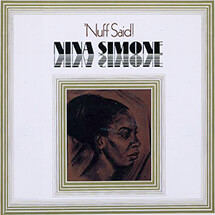
'NUFF SAID (2003)
Additions: Mississippi Goddam; Don't Let Me Be Misunderstood; Come Ye; Ain't Got No / I Got Life; Peace of Mind
- Black Is The Color Of My True Love’s Hair
- Ain’t Got No, I Got Life
- Westwind
- Who Knows Where The Time Goes
- The Assignment Sequence
- To Be Young, Gifted, and Black
- Nina Simone – vocals, piano, arrangements
- Emile Latimer – guitar, vocals on “Black Is The Color Of My True Love’s Hair”
- Weldon Irvine – organ
- Don Alias – drums, percussion
- Jumma Santos – congas, percussion
- Andy Stroud – producer
- Ed Begley – recording engineer
- Jack Medkiff – cover design
Recording session: Philharmonic Hall – New York City – October 26, 1969
Catalog number: LSP-4248
Liner notes (by Mike Butler, from 2002 CD of Emergency Ward/It Is Finished/Black Gold):
The stage is Nina Simone’s natural arena. This is the place to experience Nina’s unflinching honesty and naked emotionalism in unmediated purity. Live recordings can’t convey the tension and sense of occasion of a Simone performance, but they give a reasonable impression of her indomitable life force and volatility.
Four out of Nina Simone’s nine albums for RCA are live recordings. Townes Van Zandt once mentioned that he would have to stop releasing live albums or people would think he was dead (Townes was late and great before his death in 1977). Simone, who is thankfully still alive, has been well represented by live recordings throughout her career. This package gathers three of them: Black Gold (1970), Emergency Ward (1972) and It Is Finished (1974).
Black Gold carries unpretentiousness to a fault, and is notable for lovely renditions of Black Is The Color (which she recorded on her first concert album, Live At Town Hall, in 1959) and Who Knows Where The Time Goes (a dream encounter between Nina and Sandy Denny). Simone’s performance is marked by extraordinary sensitivity and an aching, curious sense of wonder. The atmosphere is so relaxed and collaborative that Nina permits guitarist Emile Latimer to sing an alternative to Black Is The Color.
The record chiefly achieves immortality by including the premiere version of Young, Gifted & Black. The phrase comes from Lorraine Hansberry, the author of Raisin In The Sun, the first hit play on Broadway by a black writer and the person whom Nina credits as the source of her political education. Weldon Irvine Jr, then Nina’s musical director, wrote the words.
Says Irvine: “I was very honored that Nina Simone asked me to write those lyrics in 1968. The song reflects the aspirations and conditions of black people in America: young people caught up in a time when things were happening which made people proactive rather than apathetic. It makes me proud that thirty years later young students all over the US sing Young, Gifted & Black.” The song became the anthem of the civil rights movement but there is no bitterness here, only warmth and a yearning that gives greater strength to the sentiment.
Personal and political torment had escalated by the time of Emergency Ward (which is, strictly speaking, only half a live album). The newspaper headlines that adorn the original cover scream “Laser-Guided Bombs” (nothing new under the sun, it seems) and “Viet Push”, and fix the 1972 album firmly in its time. The Vietnam War is the unspoken fact that dominates the album. The live segment was recorded at Fort Dix, a military base in New Jersey, before an audience primarily composed of black GIs. The tone is apocalyptic: an expectation of the imminent end tends to concentrate the mind on spiritual matters.
Emergency Ward is a reckoning, a one-sided dialogue between Nina and her Creator. “Isn’t it a pity, My God?” is her message.
In 1971, empowered by Marvin Gaye’s What’s Going On (and Sly Stone’s more disturbing There’s A Riot Goin’ On) soul music had entered a new phase: serious enough to expose the ills of the nation, and powerful enough to dispense spiritual healing.
Nina had anticipated the change. Backlash Blues from Sings the Blues, to give one example, offers and important analysis of black politics and the white world. The overlooked masterwork of Nina Simone & Piano transcends black politics to address the concerns of the entire human family.
Vindicated by the new spirit, Nina’s response was to return to her gospel roots. Emergency Ward documents her collaboration with the Bethany Baptist Church Junior Choir of South Jamaica, NY. The main item on the program was to be an extended My Sweet Lord, the neo-gospel anthem by George Harrison. Advance reports suggested a restatement of the simple faith of Nina’s upbringing (as the sixth child of a preacher’s family in rural North Carolina). Advance reports were wrong. Nina Simone, like the Lord, moves in mysterious ways.
Handclaps and massed “Hallelujahs” accompany Nina as she yearns for spiritual union and declares impatience with the slow pace of mystic revelation. The groove is disrupted and the choir is quelled as Nina introduces a second theme – her setting of a poem by David Nelson, Today Is a Killer. This develops (after a reprise of My Sweet Lord) into a meditation on the contrast between the innocence of nature and a rapacious, man-made world.
The link between Harrison’s uplifting spiritual and Nelson’s somber poem isn’t made clear until the final moment, and Nina declares “Today, who are you Lord? YOU ARE A KILLER!” as the choir chimes with a grand, affirmative “Hallelujah”.
It is a staggering moment, with more impact because of the sacred context. To co-opt the Bethany Baptist Church Junior Choir of South Jamaica, NY, into this act of blasphemy is a masterstroke of subversion. Nina is known for her willfulness and feats of audacity, but this surpasses everything.
The valedictory title of the following album says it all: It Is Finished is Nina’s farewell to militancy, to her record label and to America. Fittingly, there are backward glances; an affectionate homage to Bill “Bojangles” Robinson, an earlier black hero, and a dedication to Bessie Smith, with the sexy Sugar In My Bowl. The Pusher, an unsparing account of the devastation wreaked by drugs, makes clear why escape was necessary.
Having spent fifteen years running, it was time for Nina to relax and take stock. She moved to Barbados in 1974, and subsequently lived in Liberia. The role of freedom fighter had broken down in the face of social and personal problems. Nothing daunted, Simone reinvented herself as the Obeah Woman. The African-rooted, classically trained pianist freely moved between ‘civilization’ and ‘savagery’ (both are tricky concepts and need those inverted commas). The dark and fearful Dambala visits a place beyond death and reveals the secrets that only the Obeah Woman knows.
- Medley
- My Sweet Lord
- Today Is A Killer
- Poppies
- Isn’t It A Pity
- Nina Simone – vocals, piano, producer
- Bethany Baptist Church Junior Choir of South Jamaica, New York – choral group
- Samuel Waymon – vocals
- Lisa Stroud – polyrhythms
- Weldon Irvine – orchestrations, producer
- Andy Stroud – producer
- Ed Begley – recording engineer
Recording session: Fort Dix – November 18, 1971
Catalog number: LSP-4757
Liner notes (by Mike Butler, from 2002 CD of Emergency Ward/It Is Finished/Black Gold):
The stage is Nina Simone’s natural arena. This is the place to experience Nina’s unflinching honesty and naked emotionalism in unmediated purity. Live recordings can’t convey the tension and sense of occasion of a Simone performance, but they give a reasonable impression of her indomitable life force and volatility.
Four out of Nina Simone’s nine albums for RCA are live recordings. Townes Van Zandt once mentioned that he would have to stop releasing live albums or people would think he was dead (Townes was late and great before his death in 1977). Simone, who is thankfully still alive, has been well represented by live recordings throughout her career. This package gathers three of them: Black Gold (1970), Emergency Ward (1972) and It Is Finished (1974).
Black Gold carries unpretentiousness to a fault, and is notable for lovely renditions of Black Is The Color (which she recorded on her first concert album, Live At Town Hall, in 1959) and Who Knows Where The Time Goes (a dream encounter between Nina and Sandy Denny). Simone’s performance is marked by extraordinary sensitivity and an aching, curious sense of wonder. The atmosphere is so relaxed and collaborative that Nina permits guitarist Emile Latimer to sing an alternative to Black Is The Color.
The record chiefly achieves immortality by including the premiere version of Young, Gifted & Black. The phrase comes from Lorraine Hansberry, the author of Raisin In The Sun, the first hit play on Broadway by a black writer and the person whom Nina credits as the source of her political education. Weldon Irvine Jr, then Nina’s musical director, wrote the words.
Says Irvine: “I was very honored that Nina Simone asked me to write those lyrics in 1968. The song reflects the aspirations and conditions of black people in America: young people caught up in a time when things were happening which made people proactive rather than apathetic. It makes me proud that thirty years later young students all over the US sing Young, Gifted & Black.” The song became the anthem of the civil rights movement but there is no bitterness here, only warmth and a yearning that gives greater strength to the sentiment.
Personal and political torment had escalated by the time of Emergency Ward (which is, strictly speaking, only half a live album). The newspaper headlines that adorn the original cover scream “Laser-Guided Bombs” (nothing new under the sun, it seems) and “Viet Push”, and fix the 1972 album firmly in its time. The Vietnam War is the unspoken fact that dominates the album. The live segment was recorded at Fort Dix, a military base in New Jersey, before an audience primarily composed of black GIs. The tone is apocalyptic: an expectation of the imminent end tends to concentrate the mind on spiritual matters.
Emergency Ward is a reckoning, a one-sided dialogue between Nina and her Creator. “Isn’t it a pity, My God?” is her message.
In 1971, empowered by Marvin Gaye’s What’s Going On (and Sly Stone’s more disturbing There’s A Riot Goin’ On) soul music had entered a new phase: serious enough to expose the ills of the nation, and powerful enough to dispense spiritual healing.
Nina had anticipated the change. Backlash Blues from Sings the Blues, to give one example, offers and important analysis of black politics and the white world. The overlooked masterwork of Nina Simone & Piano transcends black politics to address the concerns of the entire human family.
Vindicated by the new spirit, Nina’s response was to return to her gospel roots. Emergency Ward documents her collaboration with the Bethany Baptist Church Junior Choir of South Jamaica, NY. The main item on the program was to be an extended My Sweet Lord, the neo-gospel anthem by George Harrison. Advance reports suggested a restatement of the simple faith of Nina’s upbringing (as the sixth child of a preacher’s family in rural North Carolina). Advance reports were wrong. Nina Simone, like the Lord, moves in mysterious ways.
Handclaps and massed “Hallelujahs” accompany Nina as she yearns for spiritual union and declares impatience with the slow pace of mystic revelation. The groove is disrupted and the choir is quelled as Nina introduces a second theme – her setting of a poem by David Nelson, Today Is a Killer. This develops (after a reprise of My Sweet Lord) into a meditation on the contrast between the innocence of nature and a rapacious, man-made world.
The link between Harrison’s uplifting spiritual and Nelson’s somber poem isn’t made clear until the final moment, and Nina declares “Today, who are you Lord? YOU ARE A KILLER!” as the choir chimes with a grand, affirmative “Hallelujah”.
It is a staggering moment, with more impact because of the sacred context. To co-opt the Bethany Baptist Church Junior Choir of South Jamaica, NY, into this act of blasphemy is a masterstroke of subversion. Nina is known for her willfulness and feats of audacity, but this surpasses everything.
The valedictory title of the following album says it all: It Is Finished is Nina’s farewell to militancy, to her record label and to America. Fittingly, there are backward glances; an affectionate homage to Bill “Bojangles” Robinson, an earlier black hero, and a dedication to Bessie Smith, with the sexy Sugar In My Bowl. The Pusher, an unsparing account of the devastation wreaked by drugs, makes clear why escape was necessary.
Having spent fifteen years running, it was time for Nina to relax and take stock. She moved to Barbados in 1974, and subsequently lived in Liberia. The role of freedom fighter had broken down in the face of social and personal problems. Nothing daunted, Simone reinvented herself as the Obeah Woman. The African-rooted, classically trained pianist freely moved between ‘civilization’ and ‘savagery’ (both are tricky concepts and need those inverted commas). The dark and fearful Dambala visits a place beyond death and reveals the secrets that only the Obeah Woman knows.
EXPANDED EDITIONS:
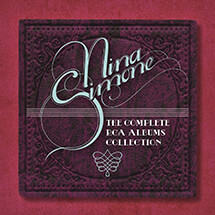
THE COMPLETE RCA ALBUMS COLLECTION (2011)
Additions: Let It Be Me
- The Pusher
- Com’ By H’Yere
- Funkier Than A Mosquito’s Tweeter
- Mr. Bojangles
- I Want A Little Sugar In My Bowl
- Dambala
- Let It Be Me
- Obeah Woman
- Nina Simone – vocals, piano, arrangements, producer
- Samuel Waymon – harmony vocals
- Avram/Al Schackman – sitar, guitar, bass
- Nadi Qamar – thumb piano
- Harold Wheeler – conductor, arrangements, producer
- Ed Begley –engineering, remixing
- Bruce Somerfeld – remixing, executive producer
- Nat Shapiro – producer
- Guille Roland – design
- Jim Bell – photography
Catalog number: APL1-0241
Liner notes (by Mike Butler, from 2002 CD of Emergency Ward/It Is Finished/Black Gold):
The stage is Nina Simone’s natural arena. This is the place to experience Nina’s unflinching honesty and naked emotionalism in unmediated purity. Live recordings can’t convey the tension and sense of occasion of a Simone performance, but they give a reasonable impression of her indomitable life force and volatility.
Four out of Nina Simone’s nine albums for RCA are live recordings. Townes Van Zandt once mentioned that he would have to stop releasing live albums or people would think he was dead (Townes was late and great before his death in 1977). Simone, who is thankfully still alive, has been well represented by live recordings throughout her career. This package gathers three of them: Black Gold (1970), Emergency Ward (1972) and It Is Finished (1974).
Black Gold carries unpretentiousness to a fault, and is notable for lovely renditions of Black Is The Color (which she recorded on her first concert album, Live At Town Hall, in 1959) and Who Knows Where The Time Goes (a dream encounter between Nina and Sandy Denny). Simone’s performance is marked by extraordinary sensitivity and an aching, curious sense of wonder. The atmosphere is so relaxed and collaborative that Nina permits guitarist Emile Latimer to sing an alternative to Black Is The Color.
The record chiefly achieves immortality by including the premiere version of Young, Gifted & Black. The phrase comes from Lorraine Hansberry, the author of Raisin In The Sun, the first hit play on Broadway by a black writer and the person whom Nina credits as the source of her political education. Weldon Irvine Jr, then Nina’s musical director, wrote the words.
Says Irvine: “I was very honored that Nina Simone asked me to write those lyrics in 1968. The song reflects the aspirations and conditions of black people in America: young people caught up in a time when things were happening which made people proactive rather than apathetic. It makes me proud that thirty years later young students all over the US sing Young, Gifted & Black.” The song became the anthem of the civil rights movement but there is no bitterness here, only warmth and a yearning that gives greater strength to the sentiment.
Personal and political torment had escalated by the time of Emergency Ward (which is, strictly speaking, only half a live album). The newspaper headlines that adorn the original cover scream “Laser-Guided Bombs” (nothing new under the sun, it seems) and “Viet Push”, and fix the 1972 album firmly in its time. The Vietnam War is the unspoken fact that dominates the album. The live segment was recorded at Fort Dix, a military base in New Jersey, before an audience primarily composed of black GIs. The tone is apocalyptic: an expectation of the imminent end tends to concentrate the mind on spiritual matters.
Emergency Ward is a reckoning, a one-sided dialogue between Nina and her Creator. “Isn’t it a pity, My God?” is her message.
In 1971, empowered by Marvin Gaye’s What’s Going On (and Sly Stone’s more disturbing There’s A Riot Goin’ On) soul music had entered a new phase: serious enough to expose the ills of the nation, and powerful enough to dispense spiritual healing.
Nina had anticipated the change. Backlash Blues from Sings the Blues, to give one example, offers and important analysis of black politics and the white world. The overlooked masterwork of Nina Simone & Piano transcends black politics to address the concerns of the entire human family.
Vindicated by the new spirit, Nina’s response was to return to her gospel roots. Emergency Ward documents her collaboration with the Bethany Baptist Church Junior Choir of South Jamaica, NY. The main item on the program was to be an extended My Sweet Lord, the neo-gospel anthem by George Harrison. Advance reports suggested a restatement of the simple faith of Nina’s upbringing (as the sixth child of a preacher’s family in rural North Carolina). Advance reports were wrong. Nina Simone, like the Lord, moves in mysterious ways.
Handclaps and massed “Hallelujahs” accompany Nina as she yearns for spiritual union and declares impatience with the slow pace of mystic revelation. The groove is disrupted and the choir is quelled as Nina introduces a second theme – her setting of a poem by David Nelson, Today Is a Killer. This develops (after a reprise of My Sweet Lord) into a meditation on the contrast between the innocence of nature and a rapacious, man-made world.
The link between Harrison’s uplifting spiritual and Nelson’s somber poem isn’t made clear until the final moment, and Nina declares “Today, who are you Lord? YOU ARE A KILLER!” as the choir chimes with a grand, affirmative “Hallelujah”.
It is a staggering moment, with more impact because of the sacred context. To co-opt the Bethany Baptist Church Junior Choir of South Jamaica, NY, into this act of blasphemy is a masterstroke of subversion. Nina is known for her willfulness and feats of audacity, but this surpasses everything.
The valedictory title of the following album says it all: It Is Finished is Nina’s farewell to militancy, to her record label and to America. Fittingly, there are backward glances; an affectionate homage to Bill “Bojangles” Robinson, an earlier black hero, and a dedication to Bessie Smith, with the sexy Sugar In My Bowl. The Pusher, an unsparing account of the devastation wreaked by drugs, makes clear why escape was necessary.
Having spent fifteen years running, it was time for Nina to relax and take stock. She moved to Barbados in 1974, and subsequently lived in Liberia. The role of freedom fighter had broken down in the face of social and personal problems. Nothing daunted, Simone reinvented herself as the Obeah Woman. The African-rooted, classically trained pianist freely moved between ‘civilization’ and ‘savagery’ (both are tricky concepts and need those inverted commas). The dark and fearful Dambala visits a place beyond death and reveals the secrets that only the Obeah Woman knows.
- Pirate Jenny
- For A While
- You Took My Teeth
- I Want A Little Sugar In My Bowl
- Backlash Blues
- Do What You Gotta Do
- Mississippi Goddam
- See-Line Woman
- The Other Woman
- I Loves You, Porgy
- Four Women
- I Sing Just To Know That I’m Alive
- My Baby Just Cares For Me
- Nina Simone – vocals, piano
- Al Schackman – guitar
- Leopoldo Fleming – percussion
- Cornell McFadden – drums
- Linda Garhan – executive producer
- Eddie Singleton – producer
Recording session: Various venues during U.S. tour – 1985
Catalog number: 260-07-107
Liner notes:
There are rising stars, shooting stars, fallen stars, and then there are those stars that come into being, that assume their destined position in our cosmic universe and remain fixed forever, glowing in constant vigilance, bringing with it a rejuvenating energy force that tends to validate the right for self-determined existence.
Such a star is Nina Simone. Born to enlighten thru her gifted artistry as she showers planet earth with her lyrical, melodious vignettes, depicting life between the keys.
Nina Simone — Live and Kickin was recorded live in 1985, during the course of her most recent intercontinental tour. Each song selected for this set was so chosen in testimony that our star of stars, after 30 years shining, Dr. Nina Simone is still very much…Live and Kickin.
ALTERNATE COVERS:

- My Baby Just Cares For Me
- I Want A Little Sugar In My Bowl
- Fodder In Her Wings
- Be My Husband
- Just Like A Woman
- Balm In Gilead
- Stars
- If You Pray Right (Heaven Belongs To You)
- Medley
- If You Knew
- Let It Be Me
- Four Women
- Mississippi Goddam
- Baltimore
- Nina Simone – vocals, piano
- Arthur Adams – guitar, bass
- Cornell McFadden – drums
- Miriam Cutler – producer
- Ron Berinstein – producer
- David Kreisberg – engineer, producer
- Nick Dofflemeyer – engineering
- Larry Walsh – editing
- Bill Levy – art direction
- Chris Whorf – design
- Sherry Rayn Barnett – photographer
Recording session: Vine Street Bar and Grill – Hollywood, California – 1985
Catalog number: 831-437-1
- God God God
- If You Knew
- Mr. Smith
- Fodder In Her Wings
- Be My Husband
- I Loves You, Porgy
- The Other Woman
- Mississippi Goddam
- Moon Over Alabama
- For A While
- See-Line Woman
- I Sing Just To Know That I’m Alive
- My Baby Just Cares For Me
- Nina Simone – vocals, piano
- Paul Robinson – drums
Recording session: Ronnie Scott’s – London – November 17, 1985
Catalog number: WHCD0006
ALTERNATE COVERS:

